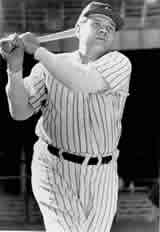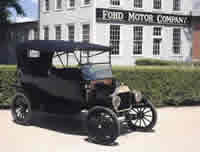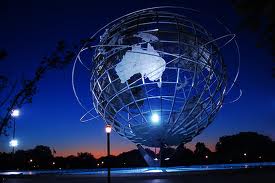
Summary of the Interwar Years
The American Century. The 20th century would become known as the "American Century," and by 1920 the essential elements of America's status as a world power were in place. The United States was an industrial giant, it had been governed since the turn of the century by two strong presidents who were more than willing to intervene in the international arena, and it had delivered 2 million American soldiers onto French soil to help turn the tide of the First World War. The population stood at 106 million, a 39% increase since 1900. America was clearly in a position to continue its position of influence in world affairs. Instead, and despite the precedent of the first two decades of the century, the country reverted to isolationism for the best part of two decades.
This section begins with the tumultuous decade of the 1920s, when old Victorian morals were abandoned and new attitudes and behaviors shocked much of the nation. The 20s saw a booming American economy, a Golden Age of sports, and a time when radios, movies, low cost automobiles, telephones and new household appliances transformed society. Advances in transportation were dramatically illustrated by Charles Lindbergh's solo flight across the Atlantic in 1927. In that same year the first talking moving picture, The Jazz Singer, was produced, and Babe Ruth hit 60 home runs. Fortunes rose and anything seemed possible, but then it all came to a crashing halt in 1929 when the stock market crashed.
The next decade was dominated by the Great Depression, and many Americans began to lose faith in the capitalist system. Just as Theodore Roosevelt had shored up the American economic system, his cousin Franklin's New Deal kept the country from falling apart. But it was a struggle.
Throughout the two decades, America was focused inward, with little attention paid to the rest of the world following the disappointing aftermath of the Great War. During the 1920s, the great powers, reeling from the devastation of the Great War, sought to find ways of avoiding another devastating conflict. Despite attempts at disarmament, however, along with proclamations denouncing further participation in war, the world drifted toward yet another calamity. Because America was preoccupied with its own affairs and wanted to avoid European entanglements, it ignored the ominous signs coming from both Europe and Japan until the next great war erupted.
Around 1970 a book was published by Alvin Toffler titled Future Shock. The book was about what happens when people can no longer cope with the pace of change. It is interesting that in the 50 years since the book was published, the pace of change has accelerated: merely keeping up with the latest developments in the cyber world is but one small measure of how rapidly things are evolving. Equally interesting is to go back 50 years from the time of the publication of Future Shock to 1920. The world had changed a great deal since the end of the Civil War, but the 1920s brought about even more revolutionary changes.
Although change was steady and dramatic, some things seemed to remain the same. Only two Democratic presidents had been elected since the Civil War, and the trend of Republican holders of the White House seemed destined to continue. Immigration, which had reached a flood by 1900, slowed dramatically, thanks to new fears about the changing face of the nation. No one could claim, however, that things were standing still. The world was moving forward. As the world slowly recovered from the war, things began to seem better, especially in the United States; the nation had suffered far less previously in terms of casualties than the major nations of Europe. Things seem to be looking up—the stock market rose, cheaper cars became available to the middle classes, and even Henry Ford's model T was within the reach of many.

The Twenties. This era begins with the Roaring Twenties, a decade that stands apart as a dividing line between the 19th and 20th centuries. Likewise, the World War I was in ways a combination of the imperialist drive that was part of the 19th century and a bridge to a new. Dominated by spectacular advances in the machinery of war it helped create what became the modern age—the 20th Century. Thus it is not too far amiss to say that in a real sense the 19th century ended at Versailles, and the 20th century began in 1920.
 The twenties thus stand apart from other the periods in American history that both preceded and followed them; they belonged to neither the past nor the future of the country. Many Americans lived high, and those at the lower end of the economic spectrum were able to see possibilities for the future. Marvelous new inventions and means of communication opened new vistas even for people in remote corners of the United States. For a brief time everything seemed to be pointing skyward.
The twenties thus stand apart from other the periods in American history that both preceded and followed them; they belonged to neither the past nor the future of the country. Many Americans lived high, and those at the lower end of the economic spectrum were able to see possibilities for the future. Marvelous new inventions and means of communication opened new vistas even for people in remote corners of the United States. For a brief time everything seemed to be pointing skyward.
The Twenties were the age of great sports figures: Babe Ruth, Ty Cobb, Lou Gehrig, Red Grange, Knute Rockne, Helen Wills, Bill Tilden, Bobby Jones, Walter Hagen, Jack Dempsey, among others. Charles Lindbergh flew solo across the Atlantic from New York to Paris, and in the process became a hero—almost overnight he went from obscurity to being practically the most famous man in the world. Then, at the end of that raucous decade, the crash of the stock market helped trigger the worst depression in America's history. Movie stars became popular idols all across the country. New music helped shape what became known as the Jazz Age. Young people danced in ways that the older generations found scandalous, and the old Victorian sexual mores were challenged in the back seats of automobiles.
Just as the 1890s were a reckless decade and a precursor of things to come, the 1920s were also a wild and woolly period, when old values seem to be cast aside and new ideas bubbled up in many areas of American life. The decade of the 1930s is also in a sense a separate time, in that the Depression of that decade was the worst in American history and certainly stands alone in that regard. On the other hand, the isolationism of the 1930s harkens back to some extent to American isolationism of much of the 19th century.
 The industrial force the power America's rise in the late 19th and early 20th centuries lay behind America's growing dominance in international affairs. America's acquisition of an Empire at the end of the Spanish-American war placed the nation in a new relationship with other nations, especially Japan. Our participation in the Great War was another step in the transition. America, however, had always been a reluctant participant in world affairs; separated from the other major nations of the world by two oceans, the feeling of being separate, even if unequal, prevailed.
The industrial force the power America's rise in the late 19th and early 20th centuries lay behind America's growing dominance in international affairs. America's acquisition of an Empire at the end of the Spanish-American war placed the nation in a new relationship with other nations, especially Japan. Our participation in the Great War was another step in the transition. America, however, had always been a reluctant participant in world affairs; separated from the other major nations of the world by two oceans, the feeling of being separate, even if unequal, prevailed.
The point here is not to draw lines or declare beginning and end times. The point is that our history has twists and turns, beginnings and endings, and often history does repeat itself in fascinating and sometimes troublesome ways. In any case this last section of the book covers an era that changed the world in ways that would hardly have been imaginable at the dawn of the 20th century, or even as the decade of the 20s began.
In 1929, however, the crash of the stock market brought things to a screeching halt: the decade ended with a thud and was followed by a time of painful awakenings and hard labor—when labor of any kind was often very hard to find. The economic boom was over and the Great Depression crept over the landscape. The government faced unprecedented challenges and responded with unheard of solutions, as the relationships between the American people and their elected leaders were transformed. Many wealthy people suddenly found themselves penniless, and the poor had to discover new means of survival. Unemployment soared, and resources available to aid the suffering masses became meager at best.
The Great Depression. In 1933 New York Governor Franklin Roosevelt became president, and another kind of change got into high gear almost immediately: the government began to intrude more deeply into the lives of American citizens and the businesses that they operated than ever before. The Progressive Movement of Theodore Roosevelt and Woodrow Wilson lost steam during the 1920s, but during the New Deal years it accelerated once more. Nevertheless, the best efforts of FDR and his New Deal were limited: many did not survive, and suicides became almost commonplace.
Roosevelt's primary task, in coordination with the Congress, was to deal with the most devastating economic crisis in the nation's history. As we shall see later in this section, the social costs were enormous, and old political notions had to be uprooted and tossed aside in the face of the new economic realities. Governor Franklin Roosevelt won by a huge landslide, winning 472 electoral votes and 42 states the Democrats controlled both houses of Congress throughout the depression years. Southern Democrats, however, were not necessarily friends of the Roosevelt administration, being more conservative than their northern brethren. They would cause him difficulty during his second term, but in the early going, Congress fell in line behind Roosevelt's bold New Deal ideas, which she had developed as governor of New York. Having served eight years under progressive president Woodrow Wilson, Franklin Roosevelt, despite the physical infirmity caused by his bout with polio, hit the ground running.
In the international arena, the great powers sought in the 1920s to find ways of avoiding another devastating war. But the 1920s and 1930s saw a new breed of government leaders arise—charismatic fanatics whose intention was nothing less than to change the world in their favor. Lenin and Trotsky were followed by Mussolini and Hitler, and a militarist faction took over the government of Japan. Although the United States could observe those developments, for most of the 1930s Franklin Roosevelt and his administration were preoccupied with dealing with America's economic woes. But change was affecting even the way the next war would be fought; weapons were becoming more powerful, bigger faster aircraft were being added to the military arsenals of the nations, and naval warfare was being transformed with a shift from the battleship to the aircraft carrier as the most powerful weapon on the high seas.
By 1940 the world had become a very different place from the world of 1920. Nevertheless, one could repeat the French phrase, "plus ça change, plus c'est la même chose"—the more things change, the more they stay the same. The old international rivalries and power struggles left over from the pre-world war environment were reiterated. Age-old social problems of poverty and hardship continued. The fundamental structure of many societies moved ahead without much change, but the world around the people was evolving rapidly. People looked to the skies and saw airplanes; they turned on their radios and heard voices from hundreds of miles away; they could get in an automobile and drive dozens of miles in a matter of hours and across the country in a matter of days.
Then, between 1940 and 1945, the world would change in more unimaginable ways. In this section we take a deeper look at how the country arrived on the eve of World War II
Topics
|
Image of the 1939 World's Fair in New York. |
External Links |
| Sage History Home | The Twenties | The Great Depression| Updated October 30, 2021 |
